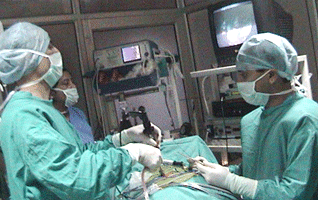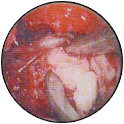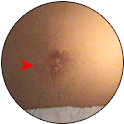| |
 |
|
Spinal Endoscopic Surgery: Treatment
Options Patient Information |
|
|
| Treatment Options |
|
| There are a number of treatment options for a ruptured lumbar
disc, each accompanied by its own set of risks and benefits.
The four basic approaches are: |
|

Endoscopic surgery in progress |
|
| 1. |
Taking Time: For some patients, all that is required
in order to heal and recover is time. |
| 2. |
Taking Medication: For others, medication may
reduce the inflammation or ease the pain in the affected
area and thereby provide relief from their symptoms. |
| 3. |
Using Physical Therapy: For some, physical measures
such as physical therapy (or gentle exercise) may provide
relief and aid in the recovery from a ruptured disc. |
| 4. |
Having Surgery: For those patients whose ruptured
disc is causing a "pinched" nerve, a Micro Endoscopic
procedure often is the recommended treatment. |
|
|
| When a Endoscopic Spinal Procedure is NOT
an Option |
|
| The severity of your symptoms (pain,
weakness, lack of mobility) and your general health and physical
condition will play an important part in determining when surgery
is not an option for you. In general, surgery is not an option
when: |
|
| 1. |
your back and leg pain is not caused by a ruptured disc;
or |
| 2. |
you do not have leg symptoms; |
| 3. |
there is a medical reason which prevents you from having
surgery; |
| 4. |
medication which reduces swelling or relieves pain would
provide you with adequate relief; |
| 5. |
physical measures would improve your condition. |
|
| |
| When is a Spinal Endoscopic Procedure an
Option? |
| |
| A lumbar microdiscectomy
can be an option for treating low back pain and numbness and
tingling in the legs. This type of surgery is performed by orthopedic
surgeons and neurosurgeons who are experts in diagnosing the
causes of back and neck pain and recognizing when a patient
is likely to get better with surgery. However, surgery is not
always the first option, and it is usually recommended only
when specific conditions are met. Surgery is usually recommended
when a ruptured disc is causing back pain and pinching a spinal
nerve root(s) and only after the pain has failed to improve
with time, physical therapy, and medications. The specific indications
for performing a discectomy include: |
| |
| |
Leg pain which limits your normal daily activities |
| |
Weakness in you leg(s) or feet |
| |
Numbness in your extremities |
| |
Impaired bowel and/or bladder function |
|
| |
| If you, or someone in your family
is experiencing these types of symptoms, then you should see
an orthopedic surgeon or a neurosurgeon who specializes in spine
surgery. Your surgeon will be able to discuss what type of procedures
might be right for you and whether or not you would be a candidate
for a microsurgical discectomy. |
| |
| The Risks of Having Surgery |
| |
| Some of the more common risks of
having any surgery include excessive bleeding, infection, or
a negative reaction to anesthesia. Clinical experience and scientific
calculation indicate that these risks are low, but surgery is
still a human effort. You should feel free to ask any questions
you have about your specific risk factors. |
| |
| Since the procedure involves surgery
in and around the spine, further nerve damage is a possibility.
In some cases, the nerve is already so damaged that the surgical
procedure required to simply reach the nerve could be the "straw
that breaks the camel's back." The end result could be
numbness, paralysis or a loss of bowel and bladder control.
(However, deciding not to have surgery may have exactly the
same consequences. Your decision should be based on a weighing
of the risks of having surgery versus the risks of not having
surgery.) |
| |
| The Benefits of Having Surgery |
| |
| You can think of surgery as the
first step in the healing and recovery process. It can help
relieve pressure on your spinal nerve(s) and, thereby, help
relieve your pain. It also may help you begin the process of
regaining some of the lost mobility in your extremities. |
| |
| The Endoscopic Spine Surgery Procedure
and its Specific Benefits |
| |
| The endoscopic spine surgery is
an operation on the lumbar spine performed using a surgical
endoscope and microsurgical techniques. |
| |
| The Endoscopic Disc procedure requires
only a very small incision and will remove only that portion
of your ruptured disc which is "pinching" one or more
spinal nerve roots. The recovery time for this particular surgery
is usually much less than is required for traditional lumbar
surgery. |
| |
| Your Chances for Success Your level
of healing will be determined by your age, your general health
and the severity of the damage to your spinal nerve, as well
as your attitude and your willingness to work at recovery. |
| |
 |
|
 |
|
 |
|
| Arthroscopic ACL repair |
|
Endoscopic view of disc removal |
|
Scar After Operation |
|
| |
| Making Your Decision |
| |
| When you consider your options,
keep in mind the impact your condition has on your way of life
and carefully weigh the risks and benefits of having surgery
against the risks and benefits of not having surgery. The decision
is yours. |
| |
| If You Decide to Have Surgery... |
| |
| Approach your surgery with a positive
mental attitude and with full confidence that you have made
the right decision. While the surgeon concentrates on finding
and removing the cause of your pinched nerve, you must concentrate
on the recovery process. Cooperate fully with your surgeon and
focus on the improvements you will make in the future not on
the problems of the past. |
| |
| |
| |
| |
| |
| |
| |


